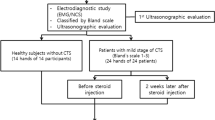Abstract
Firstly, we aimed to determine the effectiveness of various treatment modalities using ultrasonography (US), and secondly, we aimed to assess the correlations between the ultrasonographic findings and electrophysiological tests, symptom severity, functional status and physical findings. 74 hands of 47 patients with carpal tunnel syndrome (CTS) were randomly treated by applying wrist splinting alone in the neutral position (23 hands), phonophoresis with corticosteroid (PCS) (28 hands) and phonophoresis with non-steroid anti-inflamatory drug (PNSAI) (23 hands). The cross-sectional area (CSA) of the median nerve (MN) was determined by ultrasound on the initial and at the 3 months after treatment. MN conduction studies were performed on the initial visit and 3 months after treatment. The patients completed the Boston symptom severity questionnaire. For clinical evaluation, we used Phalen’s and Tinel’s signs. We could find reduction in CSA of MN in PCS group (P < 0.001). The CSA of MN was inversely correlated with motor sensory and median nerve conduction velocity (NCV) (r = 0.421, r = 0.213, respectively). Statistically significant correlations were not detected between ultrasonographic parameters and clinical evaluation parameters (P > 0.05) and also between ultrasonographic parameters and BQ scores (P > 0.05). Although there was some improvement in clinical parameters, ultrasonographic parameters did not change in P-NSAI group. Conclusion: The most effective treatment modality was P-CS according to ultrasonographic and other findings. Although there were inverse correlations between the CSA of MN and sensory and motor MN conduction velocity, no relationship was found between symptom severity, functional status and US findings or electrophysiological studies.

Similar content being viewed by others
References
Beekman R, Visser LH (2003) Sonography in the diagnosis of carpal tunnel syndrome: a critical review of the literature. Muscle Nerve 27:26–33
Uchiyama S, Itsubo T, Yasutomi T et al (2005) Quantitative MRI of the wrist and nerve conduction studies in patients with idiopathic carpal tunnel syndrome. J Neurol Neurosurg Psychiatry 76:1103–1108
Yeşildağ A, Kutluhan S, Şengul N et al (2004) The role of ultrasonographic measurements of the median nerve in the diagnosis of carpal tunnel syndrome. Clin Radiol 59(10):910–915
Jablecki CK, Andary MT, So YT et al (1993) AAEM quality assurance committee. Literature review of the usefulness of nerve conduction studies and electromyography for the evaluation of patients with carpal tunnel syndrome. Muscle Nerve 16:1392–1414
Koyuncuoğlu HR, Kutluhan S, Yeşildağ A et al (2005) The value of ultrasonographic measurement in carpal tunnel syndrome in patients with negative electrodiagnostic tests. Eur J Radiol 56(3):365–369
Levine DW, Simmons BP, Koris MJ et al (1993) A self-administered questionnaire for the assessment of severity of symptoms and functional status in carpal tunnel syndrome. J Bone Joint Surg Am 75:1585–1592
Sezgin M, Incel NA, Serhan S et al (2006) Assessment of symptom severity and functional status in patients with carpal tunnel syndrome: reliability and functionality of the Turkish version of the Boston Questionnaire. Disabil Rehabil 28:1281–1285
Mondelli M, Filippou G, Aretini A et al (2008) Ultrasonography before and after surgery in carpal tunnel syndrome and relationship with clinical and electrophysiological findings. A new outcome predictor? Scand J Rheumatol 37:219–224
Smidt MH, Visser LH (2008) Carpal tunnel syndrome: clinical and sonographic follow-up after surgery. Muscle Nerve 38(2):987–991
Dhong ES, Han SK, Lee BI et al (2000) Correlation of electrodiagnostic findings with subjective symptoms in carpal tunnel syndrome. Ann Plast Surg 45:127–131
Padua L, Padua R, Monaco ML et al (1999) Multiperspective assessment of carpal tunnel syndrome. Neurology 53:1654–1659
Lee CH, Kim TK, Yoon ES et al (2005) Correlation of highresolution ultrasonographic findings with the clinical symptoms and electrodiagnostic data in carpal tunnel syndrome. Ann Plast Surg 54:20–23
Kaymak B, Özçakar L, Çetin A et al (2008) A comparison of the benefits of sonography and electrophysiologic measurements as predictors of symptom severity and functional status in patients with carpal tunnel syndrome. Arch Phys Med Rehabil 89(4):743–748
Author information
Authors and Affiliations
Corresponding author
Rights and permissions
About this article
Cite this article
Soyupek, F., Yesildag, A., Kutluhan, S. et al. Determining the effectiveness of various treatment modalities in carpal tunnel syndrome by ultrasonography and comparing ultrasonographic findings with other outcomes. Rheumatol Int 32, 3229–3234 (2012). https://doi.org/10.1007/s00296-011-2173-7
Received:
Accepted:
Published:
Issue Date:
DOI: https://doi.org/10.1007/s00296-011-2173-7




